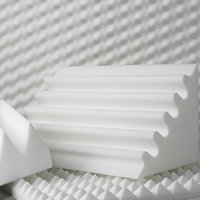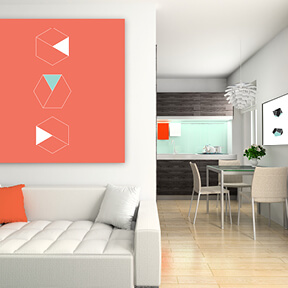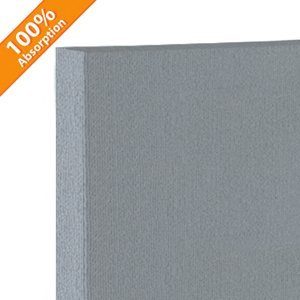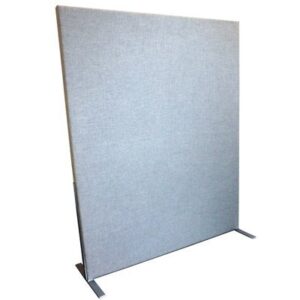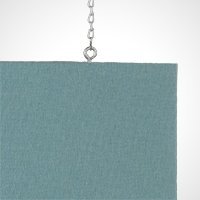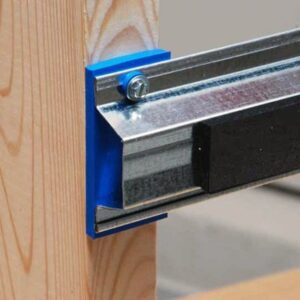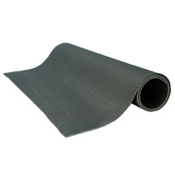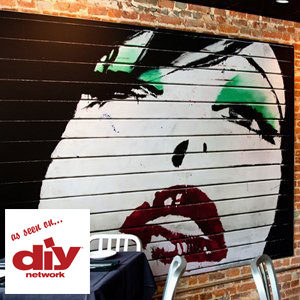-
How Can Soundproofing Improve Your Restaurant?
-
Soundproofing your restaurant can improve the experience you provide and increase sales long-term. Poor sound quality can have negative effects on both employees and customers. With the addition of soundproofing materials, your restaurant can reduce echoes, noise and shouting. Employees can hear guest orders better, and customers won’t complain about noise or shout across tables to hear each other.
-
How Can Poor Sound Quality Impact Your Business?
-
Poor sound quality affects everyone in your restaurant. For example, with noise echoing from kitchen appliances into the dining room, guests may need to increase their speaking volume to be heard across tables. Customers may also complain about noise, leading to bad reviews and fewer sales.
When it comes to the effects on employees, poor sound quality can lead to hearing damage and decreased productivity. Employees might become stressed or fatigued after working long hours in a loud space.
-
What Is an Acceptable Noise Level in a Restaurant?
-
Most restaurants aim for noise levels around 50 to 65 decibels. Even so, you should expect the noise level to increase to 70 decibels during busy times. Keep in mind that anything over 70 or 80 decibels may reach dangerous levels, which could damage hearing and cause patrons to shout over each other.
-
What Can Soundproofing Do for Your Business?
-
Soundproofing can help your business in many ways, from improving the ambiance to creating a good experience for new and returning guests. Soundproofing materials also offer a way to better serve customers and reduce order errors. The more you pay attention to the noise level needs of both employees and customers, the more likely you are to increase sales and grow your business.
-
How Do You Reduce Noise in an Open Kitchen?
-
Restaurant owners can reduce noise in open kitchens using acoustic ceiling panels. Other ways to reduce noise include the following ideas:
- Layout: Place the seating areas far from the kitchen to reduce appliance noise.
- Appliances: Consider buying appliances with quiet ratings and muffle the sound with fitted doors and soft hinges.
- Soundproof materials: Use plasterboard or wood paneling on the wall and ceiling to soundproof the restaurant.
- Texture: Create noise absorbers with rugs, curtains and cushions.
-
Restaurant Soundproofing and Sound Absorption: What's the Difference?
-
Sound absorption materials absorb sound waves and echo that might bounce off walls, floors and ceilings. They are meant to reduce background noise and muffle loud voices. Through sound absorption, customers can hear themselves speak, and employees can better hear guest orders.
Soundproofing products trap sound to contain noise in one space. They are meant to reduce noise levels in the building and create a better atmosphere for guest experiences.

You can effectively soundproof a restaurant by installing acoustic panels, hanging baffles or acoustic partitions. Acoustic panels come in a variety of designs to choose from for your restaurant soundproofing project. Adding acoustic panels to restaurants can create a comforting and quiet atmosphere while improving the quality of your services. Here are a few questions restaurant managers and owners might have when investing in soundproofing materials.
Restaurant Soundproofing FAQs
Restaurant Sound Absorption Products
Restaurant Soundproofing Products
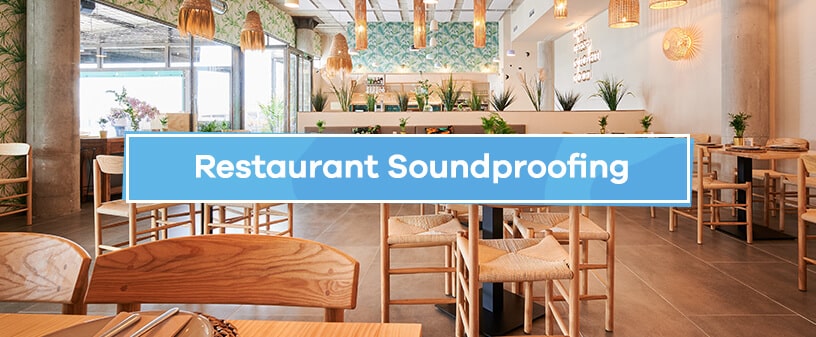
Key Takeaways:
- Layer absorption and isolation: Use acoustic wall/ceiling panels, hanging baffles, and partitions to absorb echoes; add soundproof doors, insulated walls, or mass-loaded vinyl (MLV) to block kitchen or bar noise.
- Fix layout-driven noise fast: Move soda/ice/bar stations away from diners, shield POS areas with acoustic partitions, pad chair/table legs and add tablecloths/rugs/booth cushions; treat ceilings and other hard surfaces to stop sound from bouncing.
- Aim for comfortable conversation: Target 60–70 dB. A calmer soundscape enhances taste perception and overall enjoyment, reduces order errors, and makes the space feel more welcoming. Consider a free acoustic analysis to fine-tune product choices and placement.
Restaurant Soundproofing Materials
Noise is essential to the ambience and dining experience. For those who take pride in selecting menus, good chefs and quality ingredients, paying attention to controlling noise levels may also be a good idea.
Loud noises are a major complaint among restaurant guests. Sounds can also affect diners’ perception of their meals. Noise may affect food perception in the following ways:
- Taste: Reduce guests’ ability to taste certain sweet or spicy foods.
- Smell: Loud noises may create negative smell perceptions of a meal.
- Food: Sounds may create the appearance or perception of dry food.
- Emotions: Loud noises may reduce guest happiness or satisfaction with food taste.

Many people report changing their dining habits to avoid noisy restaurants. People may avoid restaurants during busy times, while other customers avoid noisy restaurants altogether, opting for delivery.
People who go to noisy restaurants tend to eat more quickly and depart faster. While this can help turn tables over during a busy lunch rush, it can lose revenue during dinners and at bars. These diners tend to spend less and not return.
Ideas for Soundproofing Restaurants Without Renovating
If noise is a problem in your restaurant and renovation isn’t possible, there are still options. A wide variety of sound absorption materials can be added without major construction. Sometimes, just a few layout changes can significantly affect your customers’ acoustic experience.
Restaurants with large dining areas often struggle with noise problems due to sound echoes. Sound-absorbing hanging baffles dampen echoes and can be easily installed with S-hooks, chains and wire.
Hanging baffles don’t need to look industrial, either. Sound-absorbing hanging baffles are available in a wide range of colorful acoustic fabrics. You can even have designs custom-printed. That means it’s easy to turn your restaurant ceiling into a work of art while creating a dining experience that’s more appealing to your customers.
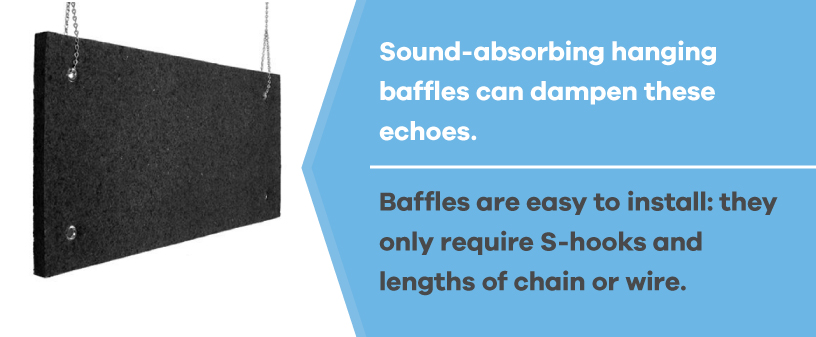
Acoustic panels are another option for cutting down on noise in a restaurant. These panels can be added to almost any wall space to absorb noise. For those restaurants that want to dampen sound, consider finding a sound-insulating panel in various styles to fit your restaurant design. Installing an acoustic panel is also one of the easier ways to reduce noise in a dining room. You can usually simply hang them using a Z-bar wall mounting system.
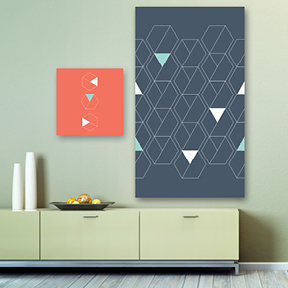
Acoustic panels for restaurants come in a variety of different styles:
- Perforated wood acoustic panels
- Fabric-wrapped acoustic panels in a variety of colors and patterns
- Art acoustic panels printed with a custom image
We know that creating a visually appealing dining room takes time and effort and we don’t think soundproofing should take away from the décor. That’s why custom-printed acoustic panels can be one of the best options for soundproofing in restaurants. These acoustic panels have a foam, cotton or glass mineral wool core to absorb noise. We’ll work with you to determine what type of material will be most effective in your restaurant. Once you’ve chosen the material and size of the panels, we’ll print your requested image and apply it on top of the panel.
Installing a soundproof door will require minimal construction. It’s also one of the best investments you can make. A soundproof door will prevent noise from the kitchen from escaping into the dining room. Since kitchens are usually much louder than the dining room, this can greatly impact your customers’ dining experience.
If you’re choosing new doors, look for doors made of a solid material. Thicker doors are better at preventing sound from carrying. If possible, avoid doors with recessed panels, glass sections or hollow cores. These areas usually allow more sound.
Gaps around the kitchen doors are usually the biggest sound leak. Door sweeps, block sound from traveling underneath the door and door seals address the door’s perimeter. Look for door sweeps and seals designed for soundproofing.
Another option is to purchase a commercial door soundproofing kit, designed especially for noisy restaurant settings. These kits include soundproofing sweeps, seals, sealant and a panel or barrier material to cover the door.
A few areas in restaurants are naturally louder than others. Soda machines and bar stations are usually at the top of the list. Ice machines are also particularly noisy. And because noise tends to spiral, the noise in these areas means nearby diners need to talk more loudly to be heard.
If you’re considering layout changes to your restaurant, moving soda machines away from the rest of the dining room will pay off. Diners will be quieter when they don’t need to speak louder than the noise from the soda machine, which will have a big impact on noise in the restaurant.
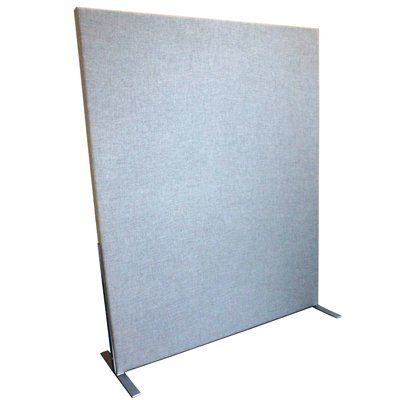
Most restaurants have a few noisy stations. Point-of-sale machines and condiment stations are often two of the biggest culprits. If possible, reposition these areas away from the main dining room. If changing the dining room’s layout isn’t possible, you have other options.
If servers use these stations primarily, consider adding an acoustic partition to separate them from the rest of the dining room. Even a single panel can help to absorb the noise in these areas. These partitions can also help block POS areas from diners’ views and reduce server noise.
Using an acoustic partition near point-of-sale areas has two advantages:
- Better dining experience: Diners have a better experience when their meal isn’t interrupted by the noise of servers trying to enter orders and make changes.
- Fewer mistakes: More quiet means that servers are less likely to make mistakes when they can concentrate on entering orders.
The ceilings in your restaurant could be playing a part in how much the noise gets amplified throughout the space. For that reason, one of the best noise reduction methods for restaurants is to soundproof the ceilings by installing sound-absorbing tiles or panels.
The process is essentially the same as what you might do to soundproof a wall or floor. By increasing the sound-dampening capabilities in your ceiling, you will be reducing vibrations and keeping the noise from transferring throughout the space. You can achieve this by adding mass and making your ceiling softer. Doing so will keep the noise from bouncing around without impacting the overall look and feel of your restaurant.
Depending on whether you are installing a new ceiling or you have one installed already, you will use a different approach. For ceilings that are being installed, you will want to use a combination of adding mass while isolating sound. Padded materials installed in key areas, like where the drywall connects to the joists, will help dampen vibrations. To soundproof an existing ceiling, you will want to use absorbent materials.
Your restaurant likely has a great deal of furniture. From the tables and chairs to decorative shelves and displays, there is a lot of material throughout that has the potential to offer soundproofing. You can create a quieter, more peaceful environment by making simple changes to your furniture.
Adding floor protector pads or caps on chairs and table legs can prevent scratching sounds when diners sit down and get up, especially if you have hardwood or tile floors. Adding tablecloths and area rugs can create more cozy spaces where noise does not have the chance to bounce around. You can also soften the sound by creating booths that are padded or cushioned.
No matter the size of the building, your decor preferences or type of cuisine your restaurant serves, your artwork can serve as more than just a design element.
Because of the way most restaurants are designed today, it is much easier for sounds to amplify and reflect throughout the space. With art acoustic panels, you can soundproof your restaurant and improve your diners’ experience — while showcasing custom images. These fabric-wrapped acoustic panels feature true-to-life colors and are designed to be fade-resistant for up to 25 years.
We carry a wide selection of art acoustic panels that work well in many different areas of a restaurant, including:
- On the wall or divider between the bar and the rest of the restaurant
- Around tables and in booths
- Hanging from the ceiling
Benefits of Restaurant Soundproofing
From a better customer and employee experience to increased health and safety, soundproofing can positively affect everyone who enters your restaurant. Other benefits of using restaurant soundproofing include the following:
- Soundproofing creates a better dining experience for customers.
- Customers are more likely to recommend restaurants with a good ambiance to others.
- Customers stay longer, spending more on extras like drinks and desserts.
- Wait staff can hear customers’ requests, reducing mistakes while taking orders.
- Employees can concentrate on multitasking.
If excessive noise is a problem in your restaurant, soundproofing solutions can be a good investment.
What Is to Blame for Loud Restaurants?
The increased noise in restaurants comes from a variety of causes. Restaurant design itself plays a role. Industrial and modern aesthetics, increasingly popular in restaurants, rely on minimalist appearances and hard surfaces that reflect sounds. Music in the dining room and guests speaking over each other can increase sound levels.
So how loud are most restaurants? Food critic Tom Sietsema noted that many restaurants had noise ratings of at least 90 decibels during busy times. The noise was so problematic that he added noise ratings to his restaurant reviews. Another food critic, Cara Buckley, recorded decibel levels of 94 to 102 at various New York restaurants. That’s equivalent to trying to eat while there’s a motorcycle 25 feet away.
Sietsema’s Restaurant Noise Rating System
Food critic Tom Sietsema’s noise rating system can help other restaurants test for proper noise levels in their building. Here are a few ratings to keep in mind:
- Quiet: Anything less than 60 decibels.
- Easy conversation: Noises between 60 to 70 decibels.
- Raised voices required: Anything from 71 to 80 decibels.
- Extremely loud: Noise levels above 80 decibels.
So it’s no surprise that many diners think restaurants have gotten too noisy. In fact, diners rate noise as the second-biggest problem when it comes to eating out. A good acoustic experience is key to creating a memorable restaurant ambiance.

Soundproofing a Restaurant
So how do you fix the problem of noisy restaurants? Creating a positive acoustic experience in a restaurant depends on several elements. Here’s what you need to know about restaurant acoustics:
- Noise: When talking about noise, we usually talk about unpleasant or discordant noises. These are sounds that don’t belong in the space. Noise that carries from a kitchen or nearby traffic falls into this category. Echoes that make it difficult to understand each other, or conversations that carry too far also apply.
- Ambiance: The right sounds can also add to the ambiance of a restaurant. Studies show that soft background music can help diners enjoy their meal, and quiet background conversation can help foster your customers’ enjoyment. That’s why acoustic design in restaurants focuses on eliminating unpleasant noises while helping pleasant ones carry.
- Soundproofing: Soundproofing uses materials and designs to trap noise in an area. Walls and doors are the most common areas to soundproof. Consider soundproofing strategies for kitchen doors and workstation areas. These materials are usually installed during construction.
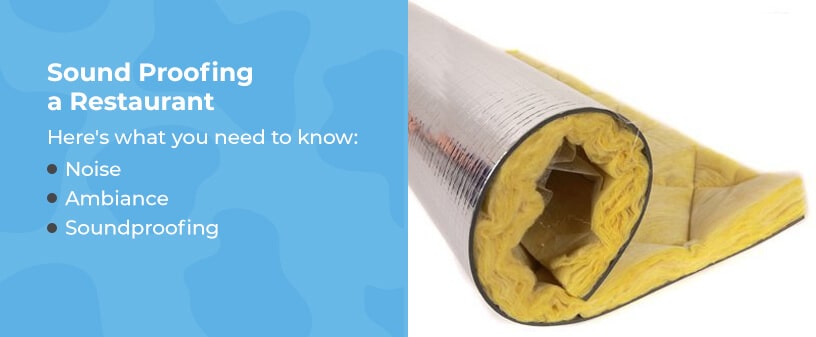
Because soundproofing traps noise, consider using it to create a buffer between loud zones and quiet ones. For instance, soundproofing will prevent the noise in the kitchen from disturbing diners. Soundproofing the door between a noisy bar and a quiet dining room is another good investment.
Sound absorption selects materials that help absorb sound, preventing it from reverberating in a space. These materials can include partitions, hanging baffles and acoustic wall panels. Even carpets can help to absorb sound.
Materials that absorb the sound can help to prevent echoes in large dining rooms. They can also help keep noises from bar stations and hostess stands from reaching diners. In general, soft material is better at absorbing sound than hard materials. If noise interferes with your diners’ experience, wall hangings, carpets and fabric-wrapped seating can all make a difference.
How Architects and Contractors Can Soundproof Restaurant Spaces
Early in the design process is the perfect time to consider soundproofing if you’re designing and building a restaurant space. There are many materials and techniques that can help you reduce noise in restaurants, but the specific materials you choose will depend on the types of noise issues you are experiencing.

Sometimes, architects and contractors look for ways to address a known noise problem. For example, if the restaurant will be near a busy road or noisy parking lot, they look for ways to reduce noise during the design phase. Some of the options you may consider include:
- Soundproofing: Utilizing soundproofing materials on exterior walls that back up against busy roads or parking lots.
- Window placement: Orient the building so that windows face quieter streets.
- Insulation: Using soundproofing insulation in exterior walls.
- Intentional quiet spaces: Placing more noise-sensitive areas, like dining rooms, farthest from the noise source.
- Noise barriers: Including noise barriers like fences, shrubbery and trees in the landscape plan.
- Loud area placement: Placing louder areas, like bars, between the noise source and the dining room/
If you don’t need to mitigate an existing noise source, considering acoustic restaurant design ideas is still useful. A restaurant space with proper soundproofing and a good acoustic experience will be more desirable than a space without it. That can mean faster leasing, lower turnover and higher rents.
Here are some soundproofing and restaurant noise reduction techniques to consider.
If the restaurant includes both a bar and a dining room, soundproofing the connecting wall is a good idea. This will prevent noise from leaking into the dining room. A soundproof wall between the bar and dining room will make filling tables near the bar easier.
There are a few different options for soundproofing this wall. Consider:
- Insulation: Adding soundproof insulation to the bar and dining room wall.
- Resilient brackets: Using acoustic resilient brackets to brace the acoustic wall to the rest of the building.
- Soundproofing barrier: Installing a soundproofing barrier or sound isolation system in the wall.
Installing a complete soundproofing system within the wall will be most effective against noise penetration. These systems usually use a combination of techniques. First, decoupling rails separate the drywall from the studs to reduce the amount of noise that will carry through the wall. Next, vibration dampening pads are installed between the studs and the rails. These pads cut down on vibrations, preventing residual noise from carrying through the wall.
Restaurant floors, particularly in large dining rooms, are a major noise source. Footsteps, chair legs and serving trays can all cause unpleasant noises that echo in a dining room. Because most restaurants use tile, stone or wood floors, you also won’t benefit from the sound dampening that carpet provides.
That’s why an acoustic flooring underlayment can make a big difference. It consists of a rubberized membrane rolled out across the floor before the tile, stone or wood is installed. Acoustic underlayment is particularly useful when the restaurant is in a multi-floor building. If the restaurant is on the first floor, install the underlayment on the story’s floor directly above it. If it’s on a second floor or higher, such as in a mall, install it within the restaurant to minimize noise from the stores below.
Mass-loaded vinyl (MLV) is a sound barrier that can easily be added to walls before installing the drywall. This material can be used independently or in conjunction with soundproofing insulation. In restaurants, it’s particularly useful in interior walls that may not be insulated.
MLV or another soundproofing barrier will help to prevent noise from leaking between different spaces within a restaurant. Soundproofing barriers are a good choice for interior walls of the kitchen and dining room. Soundproofing solutions between the kitchen and dining room will be particularly noticeable because the kitchen is usually significantly noisier than the dining room. Consider a combination of an MLV barrier or acoustic insulation with soundproofing door kits for maximum effectiveness.
Why Choose Soundproof Cow?
Whether you need acoustic panels or absorbing panels for your restaurant, Soundproof Cow has the soundproofing solutions you need. We carry top brands and provide a solutions-based approach to sound reduction and acoustics. No matter what kinds of sounds you’re dealing with inside or outside your restaurant, you can trust that our team of experts will work with you to come up with the best solution.
We are committed to putting our customers first and providing individualized customer service. We will make sure that your soundproofing needs are taken care of so your employees and diners have the best restaurant experience possible.
Get in Touch With Soundproof Cow
Soundproofing a restaurant is not as difficult as it seems. With some forethought, the right materials and perhaps a few layout changes, you can make a big difference in your customers’ acoustic experience.
At Soundproof Cow, we provide solutions to help restaurants reduce noise and improve acoustics in their building. Take our free acoustic analysis if you’d like more guidance on getting started. You’ll need to know the measurements of your restaurant and what materials are on the floor, walls and ceiling. This can help give you an idea of where to start. Or, contact us directly for further assistance.
Learn More About Restaurant Soundproofing:
- Restaurant Soundproofing Materials
- Benefits of Restaurant Soundproofing
- What’s to Blame for Loud Restaurants?
- Sietsema’s Restaurant Noise Rating System
- Soundproofing a Restaurant
- How Architects and Contractors Can Soundproof Restaurant Spaces
- Ideas for Soundproofing Restaurants Without Renovating
Soundproof Other Spaces

I just wanted to send a quick thank you for your rapid response and helpfulness. I very much appreciated it. You have been responsive in every way all through the process. It has been a pleasure doing business with you and your company.
- T. Alexander

